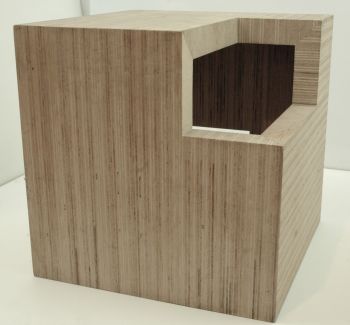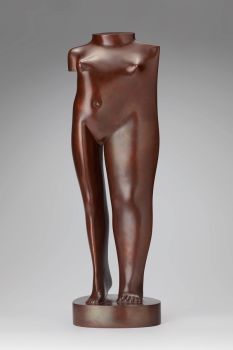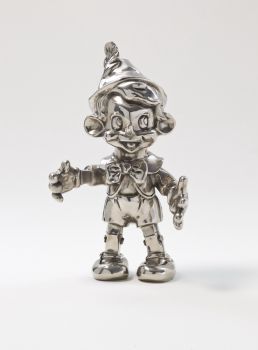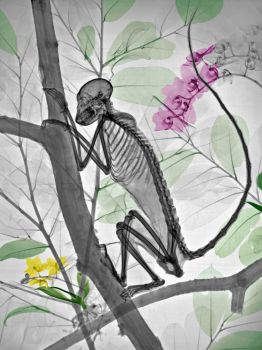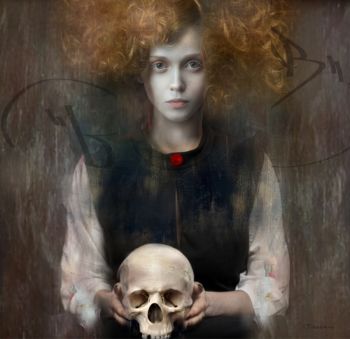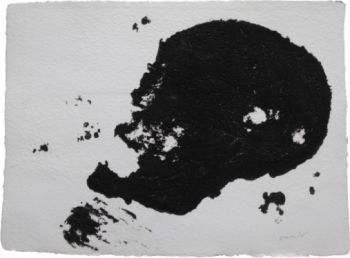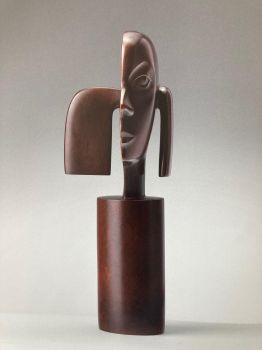“Eritis sicut Deus” 1900 - 1950
Wolfgang Hugo Rheinhold
BronzeMetal
33 cm
Price on request
Zebregs & Röell - Fine Art - Antiques
- About the artworkWolfgang Hugo Rheinhold (1853-1900)
“Eritis sicut Deus” (1st half 20th century)
Bronze on a black stone plinth, H. 33.5 cm
Hugo Rheinhold pursued a career in sculpture later in life. He commenced his career as a prosperous entrepreneur in Hamburg, engaging in trade between Germany and the United States. In 1879, he married; however, his wife soon passed away. He subsequently liquidated his business and relocated to Berlin, where he pursued studies in philosophy and sculpting. His most renowned sculpture is "The Ape with the Skull," created in 1892. The title “Eritus sicut Deus,” meaning "You will be like God, knowing Good and Evil," alludes to the words spoken by the serpent to Eve in Paradise. The book associated with Darwin, upon which the ape is perched, relates to On the Origin of Species, published in 1857. Despite Rheinhold's disagreement with the theory of evolution as a devout Jew, his sculpture attained significant prominence in numerous zoological and medical institutions globally, including the Department of Zoology at the University of Edinburgh, the Royal College of Surgeons in London, the Boston Medical Library, and even on Lenin's desk in the Kremlin.
In 1893, the Gladenbeck foundry in Berlin acquired the rights to cast the sculpture, a privilege they maintained until 1950. - About the artist
Wolfgang Hugo Rheinhold was a German sculptor and philosopher, best known for his evocative and thought-provoking work "Ape with Skull" (Affe mit Schädel), a piece that continues to captivate audiences with its philosophical depth and artistic execution. Born on March 26, 1853, in Oberlahnstein, Germany, Rheinhold's life and art were profoundly shaped by the intellectual and cultural movements of the late 19th century.
Rheinhold was born into a middle-class family in Oberlahnstein. He pursued an education in philosophy and natural sciences, which later influenced his artistic endeavors. After completing his studies, Rheinhold began his career in academia, but his growing passion for art led him to the Berlin Academy of Arts, where he trained as a sculptor.
Rheinhold's work often explored themes at the intersection of philosophy, science, and art, reflecting the intellectual ferment of the time. His most famous sculpture, "Ape with Skull", created in 1893, was directly inspired by Charles Darwin's theory of evolution and the existential questions it raised. The piece features a seated chimpanzee, holding a human skull, contemplating it with an expression of deep thought. The sculpture draws clear parallels to Hamlet's soliloquy with the skull of Yorick and serves as a commentary on humanity's place in the natural order.
The "Ape with Skull" was first exhibited at the Great Berlin Art Exhibition in 1893, where it received critical acclaim. The work became so popular that Rheinhold created multiple versions in bronze and plaster, many of which were acquired by collectors and museums across Europe and the United States.
Rheinhold's interest in philosophy, particularly the works of Darwin, Huxley, and Nietzsche, deeply influenced his artistic vision. He saw art as a medium for exploring profound questions about existence, morality, and human evolution. His sculptures were not merely decorative objects but intellectual provocations, designed to challenge viewers to reflect on their beliefs and assumptions.
Despite his success, Rheinhold's career was cut short by his untimely death on October 2, 1900, at the age of 47. He left behind a relatively small but significant body of work, much of which remains celebrated for its intellectual depth and artistic excellence.
Today, Rheinhold is remembered as a sculptor who bridged the gap between art and philosophy. His "Ape with Skull" continues to be a symbol of the human quest for understanding, a testament to the enduring relevance of his work in a modern context. The piece is prominently displayed in museums and private collections, where it inspires ongoing dialogue about science, philosophy, and art.
Are you interested in buying this artwork?
Related artworks
Klaas II Mobach
Hanna Mobach, daughter of the sculptor Klaas Mobach, reading1950 - 1970
Prezzo su richiestaKunsthandel Pygmalion
1 - 4 / 24Umberto Ciceri
Hypertrait - Female 1800 (1/1) (12 werken van 50 x 50 cm)2022
Prezzo su richiestaAbrahamArt
1 - 4 / 24- 1 - 4 / 24
Artista Sconosciuto
A silver spoon commemorating Juff’ Margareta van Hoorn1656 - 1694
Prezzo su richiestaZebregs & Röell - Fine Art - Antiques
Artista Sconosciuto
An Amazon Indigenous Kayapo feather headdress1950 - 1960
Prezzo su richiestaZebregs & Röell - Fine Art - Antiques
Artista Sconosciuto
COPPIA DI TORCHÈRE O PORTACANDELE IN TEAK INDONESI LACCATI E DORATI18th century
Prezzo su richiestaZebregs & Röell - Fine Art - Antiques
Artista Sconosciuto
A Surinam-themed Amsterdam long-case clock1746 - 1756
Prezzo su richiestaZebregs & Röell - Fine Art - Antiques
 A cura di
A cura diGallerease Magazine
1 - 4 / 12





